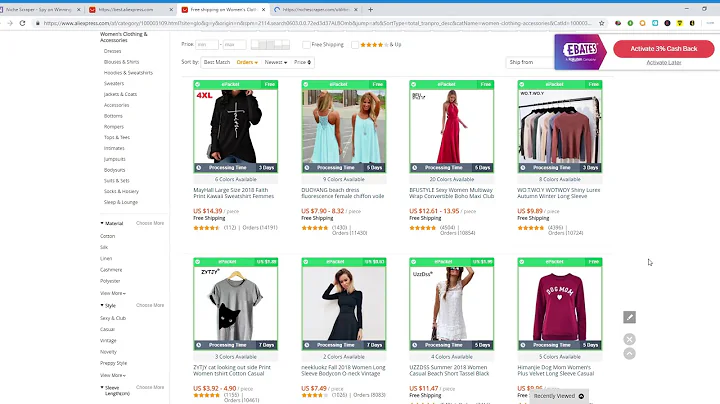Build Your Shopify Website with the Brooklyn Theme
Table of Contents:
- Introduction
- Logging into Shopify
- Choosing a Theme
- Customizing the Header
- Creating a Slideshow
- Adding Text and Buttons
- Using Images and Text
- Optimizing Product Pages
- Adding Additional Sections
- Footer Customization
- Final Thoughts
Building Your Website with Shopify: A Step-by-Step Guide
In this article, we will explore the process of building a website using Shopify's versatile themes. Whether you're a beginner or an experienced user, Shopify offers a wide range of customizable themes to suit your preferences. By following this guide, you'll be able to create a visually appealing and functional website that showcases your brand effectively. So let's dive into the step-by-step process of building your Shopify website.
Introduction
Before we begin, let's briefly introduce Shopify and its features. Shopify is an ecommerce platform that enables users to create and manage their online stores effortlessly. It provides a user-friendly interface, a wide range of customizable themes, and numerous tools to help you grow your business.
Logging into Shopify
To get started, log in to your Shopify account. Once you're logged in, click on the "Online Store" tab to access your website's theme settings. Here, you'll find different themes available, such as Debut or Brooklyn. If you wish to switch from Debut to Brooklyn, for example, simply navigate to the "Themes" section and select Brooklyn.
Choosing a Theme
Selecting a theme is an essential step in building your website. Shopify offers both free and paid themes. Browse the "Themes" section and explore various options. Once you find a theme that resonates with your brand, click on "Customize" to personalize it according to your preferences.
Customizing the Header
The header of your website plays a crucial role in creating a lasting impression on visitors. To customize the header, begin with adding your logo. Click on the logo section, select "Change," and upload your logo image. Ensure that your logo represents your brand effectively. Additionally, consider the color scheme of your website's header, keeping it simple yet eye-catching.
Creating a Slideshow
A slideshow or banner can add visual appeal and showcase your featured products or promotions. By uploading relevant images and adding compelling captions, you can draw visitors' attention and encourage them to explore your website further. Customize the slideshow settings to ensure a seamless transition between images.
Adding Text and Buttons
Strategic use of text and buttons helps guide visitors through your website and encourages them to take action. Craft catchy headings and subheadings that clearly communicate your brand message. With Shopify's user-friendly interface, you can effortlessly add buttons with relevant links, such as "Shop Now," directing visitors to product pages or other sections of your website.
Using Images and Text
Images and text can work together to enhance the visual appeal of your website. Experiment with different layouts, such as placing images on one side and text on the other for a balanced look. Ensure that your images are high-quality and reflect the essence of your brand. Craft compelling text that describes your products or services, focusing on their unique value proposition.
Optimizing Product Pages
Product pages are the heart of your ecommerce website. Pay close attention to details such as product descriptions, pricing, and high-quality product images. Highlight key features, benefits, and any special offers. Incorporate customer reviews and ratings to build trust and credibility. Finally, emphasize your customer-centric policies, such as free shipping, hassle-free returns, and 24/7 customer support.
Adding Additional Sections
To enhance the overall user experience, consider adding additional sections to your website. These sections can include testimonials, featured collections, blog posts, or social media integrations. Focus on providing relevant and engaging content that resonates with your target audience.
Footer Customization
While often overlooked, the footer of your website is an excellent opportunity to provide essential information and improve navigation. Customize the footer by adding links to pages such as privacy policy, terms of service, contact us, or refund policy. Ensure that these links are easily accessible to visitors, enabling them to find information quickly.
Final Thoughts
Building your website with Shopify offers endless possibilities for customization and growth. Remember to keep the design simple, engaging, and aligned with your brand identity. Regularly update your website with fresh content, monitor visitor behavior through analytics, and adapt your strategies accordingly. By following this step-by-step guide, you'll create a visually appealing and user-friendly website that effectively showcases your brand and boosts your online presence.
Pros:
- Easy-to-use interface for beginners.
- Wide range of customizable themes to choose from.
- Ability to add and customize various sections on your website.
- Seamless integration with payment gateways.
- Robust customer support and extensive documentation.
Cons:
- Limited flexibility in some design aspects.
- Costs associated with premium themes and additional apps.
- Advanced customization requires coding knowledge.
Highlights
- Shopify provides a user-friendly platform for building and managing online stores.
- Customizable themes and sections allow for personalized branding and design.
- Optimizing product pages for conversions is essential, including high-quality images and compelling descriptions.
- Integration with payment gateways and customer support features streamline the shopping experience.
- Regular updates and analytics monitoring help improve website performance and user engagement.
Frequently Asked Questions (FAQs)
Q: Can I switch between different themes after customizing my website?
A: Yes, you can switch between themes without losing the changes you've made. However, some elements may require adjustments to ensure consistency with the new theme.
Q: Can I add additional sections to my website apart from the ones mentioned?
A: Absolutely! Shopify allows you to add various sections according to your preferences and business needs. You can incorporate testimonials, featured collections, and more.
Q: Do I need coding knowledge to build a website with Shopify?
A: Shopify offers a user-friendly interface that doesn't require coding knowledge. However, if you wish to implement advanced customizations, coding skills are beneficial.
Q: Can I sell both physical and digital products on Shopify?
A: Yes, Shopify supports the sale of both physical and digital products. You can create product pages, manage inventory, and handle transactions seamlessly.
Q: Is Shopify suitable for beginners?
A: Yes, Shopify is beginner-friendly with its intuitive interface and extensive documentation. It provides the necessary tools and resources to set up and manage an online store efficiently.


















